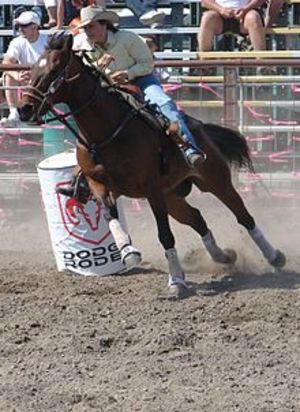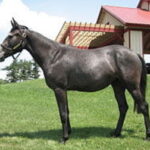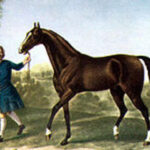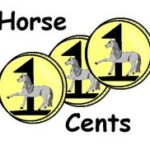There is a great variety in the conformation and temperaments of American Quarter Horses, perhaps because Thoroughbreds are allowed in the registry. Thoroughbreds also come in a great variety of temperaments and conformation. No matter how many books on Quarter Horses you read or how much promotional material you were given by the American Quarter Horse Association, chances are the first Quarter Horse you ride will not look like what you expected. But the horse will still give a great ride.
The Breed Standard
There are three types of breed standards for Quarter Horses, depending on what the horse is to be used for. A rangy, hot-tempered type is approved for racing Quarter Horses, which often have a Thoroughbred parent. A stockier, shorter-necked, round-rumped type is preferred in halter classes. Something in the middle is the idea for Western pleasure classes.
The official breed standard is that the American Quarter Horse stands from 14.2 – 16 hands high and weighs anywhere from 1,000 – 1,500 pounds. The profile of the head is straight, the eyes are large and the ears small. The back is short and slopes up from the withers to the very muscular hindquarters. Accepted colors include bay, chestnut, black, grey, dun, palomino, buckskin, cremello, perlinio, grulla and roan.
The Usual Unusual
Many Quarter Horses do not measure up to any of the breed standards. Some Quarter Horses may be too tall and some may be pony-sized. Some may have heads or hooves that seem too large for the body and some will have just the opposite problem. Some Quarter Horses do not fit the color requirements because they clearly have white markings going up over the knees and white spots on the belly.
Some Quarter Horses look downright weedy and for some reason, they are mostly chestnut in color. This writer has a personal affection for those. Although small in stature and lacking in the usual bulldog muscle that one comes to expect of a Quarter Horse, they are still intelligent, strong and bold horses. This writer had the honor of riding one of these little weedy chestnut Quarter Horses over a cross-country course that warmbloods in the group were shying away from.
Temperament
Although all horses are individuals and have their quirks, in general, Quarter Horses seem to be more willing to put up with the quirks and foibles of the people and animals they come into contact with. They also seem to not get stressed out by changes to their surroundings. If given their heads and time to explore for themselves, they can pick their way through the most rutted, rocky or steep paths.
One of the most famous Quarter Horses in recent times was Doc’s Keepin’ Time (nicknamed Justin), who appeared in many movies and television shows, including “Black Beauty” (1994). Although not so famous, countless Quarter Horses work in riding school programs, therapy horses and in police forces.
The two main health problems with Quarter Horses are having hooves that are too small for the body and a muscular condition called hyperkalemic periodic paralysis disease (HYPP.) The latter is a seizure-like condition has been traced to one stallion named Impressive (1968 – 1995), whose sire was a Thoroughbred. Unfortunately, he was one of the most sought-after sires in the history of the breed. Sometimes called Impressive Syndrome or Quarter Horse disease, about one fourth of all Quarter Horses inherited this potentially lethal condition.
Resources:
“Storey’s Illustrated Guide to 96 Horse Breeds of North America;” Judith Dutson; 2005.
“The International Encyclopedia of Horse Breeds;” Bonnie Hendricks; 1995.
“The Ultimate Horse Book;” Elwyn Hartley-Edwards; 1991.
“Horse Owner’s Veterinary Handbook;” Thomas Gore, DVM, et al.; 2008







